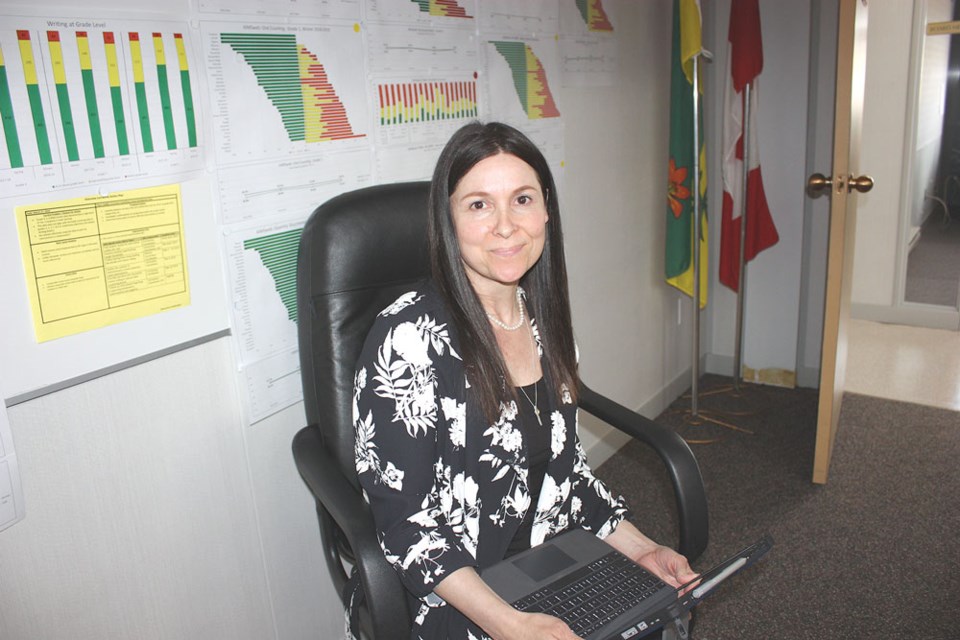Offering unique services to pre-kindergarten children and their families then tracking the progress being made on group and individual files is a daunting task.
Jacquie Gibbs, the early learning co-ordinator for the South East Cornerstone Public School Division and her 17-person team, are making strides toward overall success, sometimes with leaps and bounds, sometimes in smaller increments, with the strategic programs and activities relayed to the board members by Gibbs during their May 15 general meeting held in Weyburn.
The presentation began with Gibbs outlining the goals that call for 90 per cent of the students exiting kindergarten scoring in the appropriate range in four of the five domains with language and communications being one of the primary requirements.
Another goal is to have 80 per cent of Grade 3 students reading at or above standard levels and 80 per cent of Grades 4-8 students reading at grade level.
The early learning team consists of three elementary curriculum consultants; nine speech/language pathologists; four early learning consultants and a Kids First literacy mentor. A temporary project programmer for a community liaison for the Kids First program is now eliminated since it was funded for a minimum amount of time.
The co-ordinator said the Early Years Evaluation (EYE) project that has been a part of the Cornerstone programming since 2014, is meeting the desired targets.
Gibbs had pointed out earlier that speech/language pathologists not only address speech impediments but also delayed language skills and some of those children have intensive needs that are best attacked early so they can participate fully with their classmates.
Gibbs said there had been some setbacks regarding baseline skill growth for early learners, up to kindergarten exit. In some respects, the data collected indicated stagnant or little growth, or, slight regression, meaning a number of current kindergarten students were not doing as well as in the past. As she pointed out in response to a question, “less prepared students at the kindergarten level,” compared with previous entry-level candidates.
“We are looking for reasons. We have had some significant teacher turnovers, but our records indicate they had been trained to provide the programs so we are now considering giving some teachers more time to deliver EYE programs,” Gibbs said. “We need to tackle cognitive skill domains and collect the feedback.”
On other files, very promising moves forward were noted, with regards to the young students’ awareness of self and their environments, motor skills, social skills, language and communication and physical development. She said that often, if a child is below the base line for physical growth, they may also be falling behind in other skill development domains.
“It’s why we work with families before their kids enter school,” she said, referring to the current situation where over 190 youngsters and their families are embraced by the early learning team. It was noted that in the long run, it was a good investment since the children are better prepared to enter the structured school system.
“We do have this responsibility,” said Gibbs. “Adverse childhood experiences can be a tipping point,” whether it be abuse or some other family dysfunction or illness. When these factors are involved, the risk factors for the child are also elevated. In the data they collected, only 36 per cent of the children had no real adverse conditions holding them back, while 12 per cent had four or more issues that were negatively influencing their progress.
“However, risk is not destiny,” Gibbs said during the power point presentation.
Gibbs went on to note how special introductory programs for kindergarten kids and their parents, is a popular one with 487 families attending these welcoming events this year out of a potential of 590 families, meaning a success rate of 80 per cent.
As noted earlier, Gibbs said 192 youngsters were receiving home visiting services and those numbers vary quite a bit as situations move forward and generally improve, requiring fewer visits and consultations.
“Sure, we have reluctant parents, but once they realize how we can assist them with strategy, and if they keep trying things, it’s usually successful,” Gibbs added.
The example of a successful home visit program is the Pop Up Play Group, a program designed by Cornerstone’s team that has grown in size and popularity over the past two years. The learning experiences are proven successes in areas without a lot of back up services to call on and it helps parents and grandparents help the youngsters with such things as story circles that are inviting.
“Even little things like how the child holds a pencil or crayon, parents can observe while they play. They pay attention to what the child says and what the child is learning and it is recorded as they learn what numbers really are, and what happens at each station as the youngster learns such lessons as heavy versus light or long versus short or learn the body parts,” said Gibbs who ended the presentation on a high note of progress for an integral part of the overall Cornerstone education delivery model.
Chairwoman Audrey Trombley thanked Gibbs who had fielded a series of queries from board members during the half-hour event.



